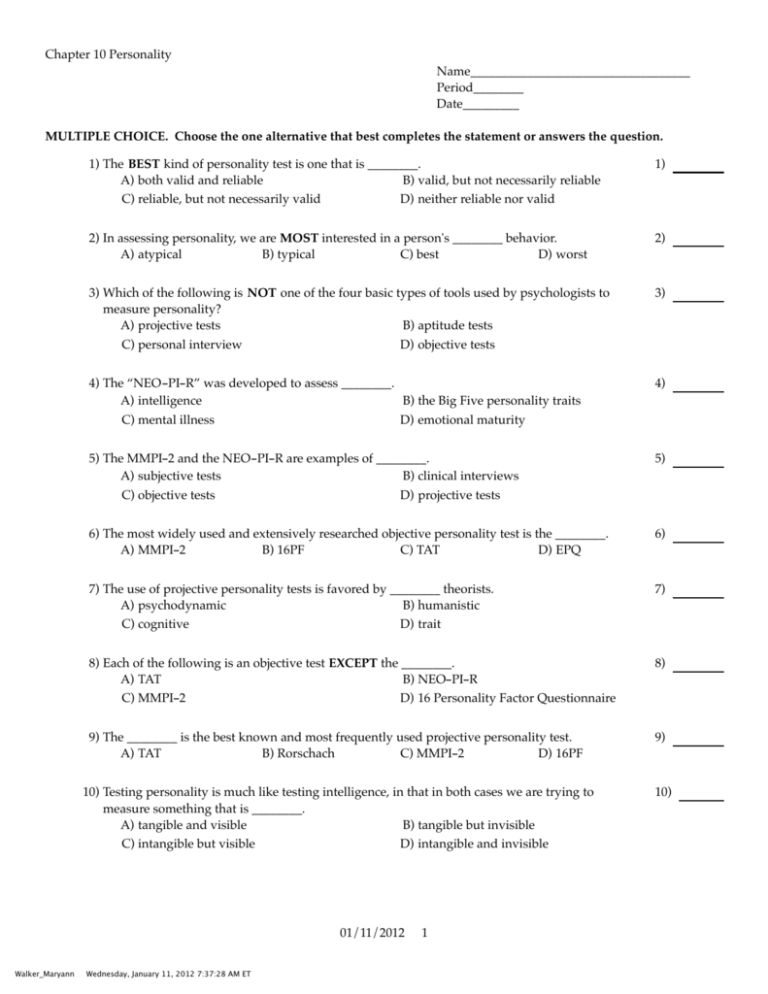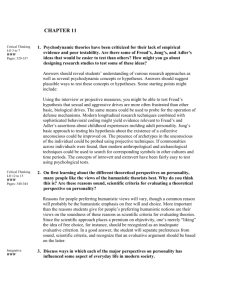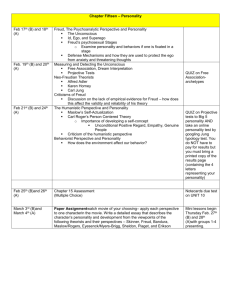Personality Test Worksheet - Psychology
advertisement

Chapter 10 Personality Name___________________________________ Period________ Date_________ MULTIPLE CHOICE. Choose the one alternative that best completes the statement or answers the question. 1) The BEST kind of personality test is one that is ________. A) both valid and reliable B) valid, but not necessarily reliable C) reliable, but not necessarily valid D) neither reliable nor valid 1) 2) In assessing personality, we are MOST interested in a person's ________ behavior. A) atypical B) typical C) best D) worst 2) 3) Which of the following is NOT one of the four basic types of tools used by psychologists to measure personality? A) projective tests B) aptitude tests C) personal interview D) objective tests 3) 4) The “NEO-PI-R” was developed to assess ________. A) intelligence B) the Big Five personality traits C) mental illness D) emotional maturity 4) 5) The MMPI-2 and the NEO-PI-R are examples of ________. A) subjective tests B) clinical interviews C) objective tests D) projective tests 5) 6) The most widely used and extensively researched objective personality test is the ________. A) MMPI-2 B) 16PF C) TAT D) EPQ 6) 7) The use of projective personality tests is favored by ________ theorists. A) psychodynamic B) humanistic C) cognitive D) trait 7) 8) Each of the following is an objective test EXCEPT the ________. A) TAT B) NEO-PI-R C) MMPI-2 D) 16 Personality Factor Questionnaire 8) 9) The ________ is the best known and most frequently used projective personality test. A) TAT B) Rorschach C) MMPI-2 D) 16PF 9) 10) Testing personality is much like testing intelligence, in that in both cases we are trying to measure something that is ________. A) tangible and visible B) tangible but invisible C) intangible but visible D) intangible and invisible 10) 01/11/2012 Walker_Maryann Wednesday, January 11, 2012 7:37:28 AM ET 1 11) The use of objective personality tests has been favored primarily by ________ theorists. A) psychodynamic B) neo-Freudian C) social learning D) trait 11) 12) The MMPI-2 was originally developed to ________. A) identify basic personality traits B) aid in the diagnosis of psychiatric disorders C) identify children of below-normal abilities D) aid in career placement 12) 13) Interviews in which the interviewer asks questions about any material that comes up, and asks follow-up questions whenever appropriate are known as ________ interviews. A) global B) wide-focus C) unstructured D) structured 13) 14) Interviews in which the order and content of the questions are fixed and the interviewer adheres to a set format are known as ________ interviews. A) wide-focus B) global C) structured D) unstructured 14) 15) To assess personality, behaviorists prefer ________. A) observation C) interviews 15) B) projective tests D) objective tests 16) The most widely used tools for assessing personality are ________. A) objective tests B) direct observations C) interviews D) projective tests 16) 17) To assess personality, social learning theorists prefer ________. A) objective tests B) projective tests C) observation D) interviews 17) 18) The Sixteen Personality Factor Questionnaire was developed by ________. A) Eysenk B) Rogers C) Cattell 19) Personality tests that are administered and scored according to a standard procedure are called ________ tests. A) response B) projective C) objective D) subjective 19) 20) Which personality test relies on the interpretation of inkblots to understand personality? A) MMPI-2 B) TAT C) 16PF D) Rorschach 20) 21) The TAT consists of ________ pictures of human figures. A) 10 B) 5 C) 20 21) 2 Walker_Maryann 18) D) Erikson Wednesday, January 11, 2012 7:37:28 AM ET D) 15 22) The accuracy and usefulness of projective tests depends largely on ________. A) the age of the client B) the type of disorder being diagnosed C) whether the client likes taking tests D) the skill of the examiner 22) 23) Each of the following is an advantage of projective tests EXCEPT ________. A) some psychologists believe that projective tests can uncover unconscious thoughts and fantasies B) since the person taking the test often doesn't know its true purpose, responses are less likely to be faked C) they have higher reliability and validity than objective tests D) because the tests are flexible, people can take them in a relaxed atmosphere 23) 24) The best known and most influential psychodynamic theorist is ________. A) Skinner B) Freud C) Maslow 24) 25) Each of the following is one of the propositions central to all psychodynamic theories EXCEPT ________. A) our mental representations of ourselves, of others, and of our relationships tend to guide our interactions with other people B) much of mental life is unconscious C) mental processes such as emotions, motivations, and thoughts operate in parallel and thus may lead to conflicting feelings D) stable personality patterns do not form until young adulthood 25) 26) Up until Freud's time, psychology had focused on ________. A) genetic influences B) the unconscious C) consciousness D) environmental influences 26) 27) Freud's theories form the basis of ________. A) humanistic psychology C) psychoanalysis 27) B) structuralism D) trait theory 28) Freud's personality theory and his form of therapy are called ________. A) cognitive theory B) rational emotive therapy C) humanism D) psychoanalysis 28) 29) For Freud, the term “sexual instinct” refers to ________. A) erotic sexuality B) childhood experiences C) the personal unconscious D) any form of pleasure 29) 30) ________ is the study of psychic energy and how it is transformed and expressed in behavior. A) Parapsychology B) Cognitive psychology C) Psychodynamics D) Gestalt psychology 30) 31) Freud believed that personality is formed around ________ structures. A) three B) five C) four 31) 3 Walker_Maryann D) Watson Wednesday, January 11, 2012 7:37:28 AM ET D) two 32) The id has ________ ways of obtaining gratification. A) four B) two C) three 33) Without using the ego, one way the id can obtain gratification is through ________. A) reflex actions B) the reality principle C) the ego ideal D) secondary processes 33) 34) According to Freud, the ego operates ________. A) partly consciously, partly preconsciously, and partly unconsciously B) only consciously C) only preconsciously D) only unconsciously 34) 35) For Freud, ideas, thoughts, and feelings of which we are currently aware are in the ________ mind. A) unconscious B) conscious C) collective unconscious D) preconscious 35) 36) For Freud, material that we are not currently aware of, but which can be easily recalled is in the ________ mind. A) unconscious B) collective unconscious C) preconscious D) conscious 36) 37) ________ theory emphasizes that humans are positively motivated and progress toward higher levels of functioning. A) Social Learning B) Trait C) Psychoanalytic D) Humanistic 37) 38) Each of the following is a humanistic psychologist EXCEPT ________. A) Rogers B) Maslow C) Adler 38) D) Perls 39) One of the most prominent humanistic psychologists was ________. A) Skinner B) Adler C) Rogers D) Frankl 40) The first humanistic psychologist was ________. A) Rogers B) Horney D) Adler 4 Wednesday, January 11, 2012 7:37:28 AM ET 39) 40) C) Maslow 41) According to Rogers, the primary goal of life is to ________. A) successfully overcome developmental challenges B) fulfill one's inborn capacities and potentialities C) understand one's personal ancestral history D) harmoniously unify the id, ego, and superego Walker_Maryann 32) D) five 41) 42) According to Rogers, which of the following persons is MOST likely to become a fully functioning person? A) someone with a strongly developed superego B) someone brought up with conditional positive regard C) someone brought up with unconditional positive regard D) someone with an extraverted personality 42) 43) According to humanistic theorists, when people lose sight of ________, they become constricted, rigid, defensive, and feel threatened and anxious. A) the goals of their ego ideal B) sense of identity C) inborn potential D) their persona 43) 44) The push toward fulfillment of our inborn capacities and potentialities is what Rogers called the ________. A) need for achievement B) compensatory process C) primary process D) actualizing tendency 44) 45) When an individual's self-concept is closely matched with his or her inborn capacities, then that person is likely to become what Rogers calls a(n) ________ person. A) actualizing B) fully functioning C) harmoniously integrated D) fully rational 45) 46) Unconditional positive regard is MOST important to ________. A) Jung B) Rogers C) Maslow 46) D) Freud 47) Critics of the humanistic approach to personality claim each of the following EXCEPT it ________. A) fails to take into account the evil in human nature B) focuses too much on universal human potential rather than individual achievement C) fosters self-centeredness and narcissism D) reflects Western values of individual achievement rather than universal human potential 47) 48) One theory suggests that people differ on a number of dimensions, such as dependency, aggressiveness, anxiety, and sociability. These characteristics are known as ________. A) personality traits B) somatotypes C) compensatory factors D) archetypes 48) 49) We infer a trait from how a person ________. A) feels B) senses 49) C) behaves 50) Gordon Allport found about ________ dictionary entries that refer to traits. A) 200 B) 18,000 C) 1,800 D) thinks 50) D) 2,000 51) Which of the following theorists would be most likely to analyze a client in terms of how she or he behaves in the present, rather than focusing on her or his early childhood? A) Cattell B) Erikson C) Rogers D) Freud 5 Walker_Maryann Wednesday, January 11, 2012 7:37:28 AM ET 51) 52) A statistical technique that identifies groups of related objects, and has frequently been use to identify clusters of traits, is ________. A) factor analysis B) scatter plotting C) a regressive measure D) a distributive measure 52) 53) Cattell originally concluded that ________ traits accounted for the complexity of human personality. A) 16 B) 3 C) 7 D) 200 53) 54) Eysenck argued that personality can be reduced to ________ basic dimensions. A) seven B) nine C) three D) five 54) 55) Which of the following is NOT one of the three basic dimensions of personality described by Eysenck? A) emotional stability B) introversion-extraversion C) neuroticism D) psychoticism 55) 56) Contemporary trait theorists have demonstrated that personality traits can be reduced to ________ basic dimensions. A) nine B) five C) seven D) three 56) 57) Recently, each of the “Big Five” traits has been shown to have ________ facets. A) six B) four C) eight D) two 57) 58) Recent research indicates that the “Big Five” are evident in people in ________. A) the United States and in other cultures B) the United States but not in other cultures C) other cultures but not in the United States D) neither the United States nor in other cultures 58) 59) Recent evidence shows that the “Big Five” and many of their individual facets are ________ influenced by heredity. A) not B) moderately C) strongly D) slightly 59) 60) Trait theories are primarily ________. A) explanatory B) experimental 60) C) anecdotal 61) The Big Five personality dimensions appear to be essentially fixed, and unlikely to change by age ________. A) 45 B) 30 C) 2 D) 15 61) 62) ________ theories find the roots of personality in the ways people think about, act on, and respond to their environment. A) Trait B) Psychodynamic C) Cognitive-social learning D) Humanistic 62) 6 Walker_Maryann D) descriptive Wednesday, January 11, 2012 7:37:28 AM ET 63) According to Bandura, standards people develop in order to rate the adequacy of their own behavior in variety of situations are called ________. A) reciprocal variables B) conditions of worth C) performance standards D) self-efficacy standards 63) 64) According to Rotter, expectancy about whether reinforcement is under internal or external control is ________. A) a performance standard B) a response set C) a self-efficacy expectation D) locus of control 64) 65) Which of the following people is most closely associated with the concept of locus of control? A) Ellis B) Seligman C) Bandura D) Rotter 65) 66) For both Bandura and Rotter, a person's expectancies become a critical part of his or her ________. A) persona B) self-actualizing tendency C) explanatory style D) ideal self 66) 67) A study of 1939 to 1944 Harvard graduates found that by age 65, optimists were ________ than pessimists. A) more intelligent B) healthier C) friendlier D) more creative 67) 68) Explanatory style and internal expectancies would be MOST important to which of the following theorists? A) Bandura B) Ellis C) Skinner D) Perls 68) 69) According to cognitive-social theorists, ________. A) underlying personality is more stable than behavior B) both behavior and underlying personality are relatively stable C) both behavior and underlying personality are relatively unstable D) behavior is more stable than underlying personality 69) 70) Many studies, conducted over more than 20 years, have found ________ between self-efficacy and performance in workplaces, schools, and clinical settings. A) a positive correlation B) widely varying correlations C) a negative correlation D) no correlation 70) 7 Walker_Maryann Wednesday, January 11, 2012 7:37:28 AM ET Answer Key Testname: PERSONALITY 1) A 2) B 3) B 4) B 5) C 6) A 7) A 8) A 9) B 10) D 11) D 12) B 13) C 14) C 15) A 16) A 17) C 18) C 19) C 20) D 21) C 22) D 23) C 24) B 25) D 26) C 27) C 28) D 29) D 30) C 31) A 32) B 33) A 34) A 35) B 36) C 37) D 38) D 39) C 40) D 41) B 42) C 43) C 44) D 45) B 46) B 47) B 48) A 49) C 01/11/2012 Walker_Maryann Wednesday, January 11, 2012 7:37:28 AM ET 8 Answer Key Testname: PERSONALITY 50) B 51) A 52) A 53) A 54) C 55) C 56) B 57) A 58) A 59) C 60) D 61) B 62) C 63) C 64) D 65) D 66) C 67) B 68) A 69) A 70) A 9 Walker_Maryann Wednesday, January 11, 2012 7:37:28 AM ET








